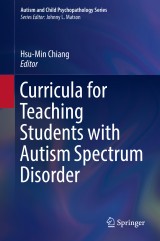Details

Curricula for Teaching Students with Autism Spectrum Disorder
Autism and Child Psychopathology Series
|
181,89 € |
|
| Verlag: | Springer |
| Format: | |
| Veröffentl.: | 24.01.2018 |
| ISBN/EAN: | 9783319699837 |
| Sprache: | englisch |
Dieses eBook enthält ein Wasserzeichen.
Beschreibungen
<p>This book provides an extensive overview of curricula and instructional strategies for teaching children with autism spectrum disorder (ASD). It offers an empirically solid framework for designing and developing interventions for learners along the autism spectrum by reducing skill deficits and enhancing learner strengths while being flexible enough to allow for individual differences. The book discusses key concepts in educating individuals with ASD as they impact the processes of syllabus building, from planning goals and objectives to generating content choosing appropriate teaching strategies, and assessing progress. Chapters detail curriculum designs in academic areas such as language skills, science, and social studies, as well as functional skills, including independent living, career development, and preventing social victimization. The book concludes with recommendations for future interventions and curricula-building.</p> <p>Among the topics covered:</p><p></p><ul><li>Communication and autism spectrum disorder.<br/></li><li>Mathematical problem-solving instruction for students with ASD.<br/></li><li>Visual arts curriculum for students with ASD.<br/></li><li>How to build programs focused on daily living and adult independence.<br/></li><li>Sexuality education for students with ASD.<br/></li></ul><p></p><p></p> <p><i>Curricula for Teaching Students with Autism Spectrum Disorder</i> is a must-have resource for researchers, graduate students, and clinicians and related therapists and professionals in clinical child and school psychology, childhood/special education, social work, developmental psychology, behavioral therapy/rehabilitation, and child and adolescent psychiatry. </p>
Chapter 1. Foundations and Development of Curricula.- Chapter 2. Theories of Teaching Students with Autism Spectrum Disorder.- Chapter 3. Communication Skills.- Chapter 4. Social Skills.- Chapter 5. Literacy Skills.- Chapter 6. Mathematics.- Chapter 7. Science.- Chapter 8. Social Studies.- Chapter 9. Creative Arts.- Chapter 10. Daily Living Skills.- Chapter 11. Abuse Prevention.- Chapter 12. Career Development.- Chapter 13. Current Trends and Future Directions.
<div><p><b>Hsu-Min Chiang, Ph.D.,</b> is an assistant professor in Faculty of Education at University of Macau. She earned her doctorate in special education from Macquarie University in Australia, M.Ed. in special education from Monash University in Australia, and B.Ed. in special education from National Tainan Teachers College in Taiwan. Before embarking on an academic career, she worked as a self-contained classroom teacher, resource room teacher, and Chinese language teacher at the early childhood, childhood, and adolescent levels. Her research has focused on various areas in autism spectrum disorders, including communication characteristics, cultural differences, academic abilities (language and mathematics), teaching strategies, postsecondary outcomes, the differences between Asperger’s disorder and autistic disorder, quality of life, and interventions for children with autism and their parents. She is the founder and director of a thematically structured Saturday enrichment program for children with autism and a parent education program for parents of children with autism.</p></div>
This book provides an extensive overview of curricula and instructional strategies for teaching children with autism spectrum disorder (ASD). It offers an empirically solid framework for designing and developing interventions for learners along the autism spectrum by reducing skill deficits and enhancing learner strengths while being flexible enough to allow for individual differences. The book discusses key concepts in educating individuals with ASD as they impact the processes of syllabus building, from planning goals and objectives to generating content choosing appropriate teaching strategies, and assessing progress. Chapters detail curriculum designs in academic areas such as language skills, science, and social studies, as well as functional skills, including independent living, career development, and preventing social victimization. The book concludes with recommendations for future interventions and curricula-building.<p>Among the topics covered:</p><p></p><ul><li>Communication and autism spectrum disorder.<br/></li><li>Mathematical problem-solving instruction for students with ASD.<br/></li><li>Visual arts curriculum for students with ASD.<br/></li><li>How to build programs focused on daily living and adult independence.<br/></li><li>Sexuality education for students with ASD.<br/></li></ul><p></p><p></p><p><i>Curricula for Teaching Students with Autism Spectrum Disorder</i> is a must-have resource for researchers, graduate students, and clinicians and related therapists and professionals in clinical child and school psychology, childhood/special education, social work, developmental psychology, behavioral therapy/rehabilitation, and child and adolescent psychiatry. </p>
Provides strategies for developing and adapting curricula and instructional strategies for children with autism spectrum disorder Examines how well-developed curricula ensure effective educational and intervention programming for children with ASD Offers detailed guidance on teaching functional skills, academic skills, and arts to children with ASD Addresses abuse prevention and career development for students with ASD

















